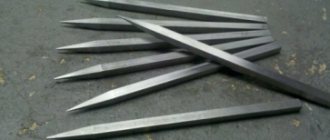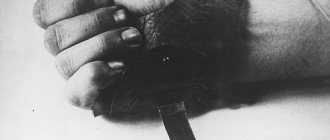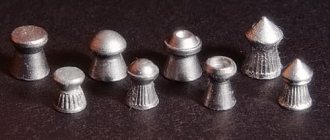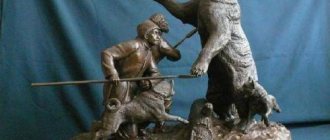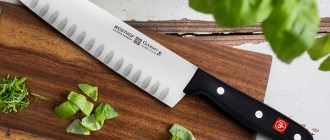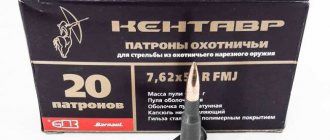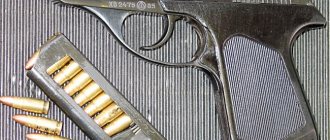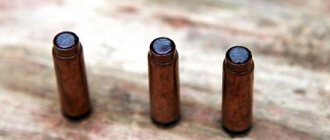| LDC | |
| NRS and NR-2 | |
| Type | bladed weapon firearms |
| A country | USSR |
| Service history | |
| In service | special units of the USSR, Russia |
| Production history | |
| Designed by | 1970s |
| Manufacturer | Tula Arms Plant[1] |
| Options | |
| Characteristics | |
| Weight, kg | 0,54 / 0,325 |
| Length, mm | 322 / 158 |
| Barrel length, mm | 100 |
| Cartridge | SP-3 |
| Caliber, mm | 7,62 |
| Work principles | barrel extraction |
| Rate of fire, rounds/min | single-shot |
| Initial bullet speed, m/s | 140 |
| Sighting range, m | 25 |
| Type of ammunition | single-shot |
| Aim | open |
| Media files on Wikimedia Commons | |
There is an abbreviation for this term, "LDC", which has other meanings: see LDC.
LDC
(
Reconnaissance
Knife
S
Special
[2][3] or Striking
[1]; GRAU index - 6P25 [ 1
a Soviet combat knife equipped with a firing device mounted in the handle [2]. Designed for the SP-3 closed-type cartridge in the 1970s by Rafail Dmitrievich Khlynin on instructions from the Ministry of Defense and the State Security Committee of the USSR[2][3]. In addition to the basic version, a version without a firing mechanism was also produced[1].
With the advent in 1983 of the silent PSS pistol chambered for the much more powerful SP-4 cartridge, the NRS knife served as the basis for the development of a similar product, the NRS-2, in order to unify the firearms arsenal in terms of ammunition[2].
Design
Blade
The shape of the blade part of the NRS knife is similar to a standard army bayonet-knife from an AKM assault rifle; however, the material chosen for the blade is steel 25Х17Н2БШ, and its coating is made in the form of “black chrome”. There is a small saw on the butt that allows you to saw through metal rods up to one centimeter thick[2].
Lever
The knife handle is plastic, usually green (less often brown) with large mesh corrugation [2]. At the rear of the handle there is a firing device consisting of:
- detachable barrel with two locking lugs and a locking mechanism,
- trigger mechanism,
- cocking lever,
- fuse box,
- release lever[2].
The barrel is directed in the direction opposite to the blade[1], its muzzle at the back of the handle is covered with rubber curtains[2]. The sight's rear sight is located on the crosshair of the knife, and the front sight in the form of a plastic protrusion is located at the rear end of the handle. To remove the spent cartridge case from the chamber, a special bent petal with a hole is provided on the knife handle [2].
Sheath
The plastic sheath is equipped with an additional folding handle in order to use it as a wire cutter for cutting a telephone cable with a diameter of up to 5 mm or a steel wire woven into two strands with a diameter of up to 2.5 mm and energized at 380 Volts. The knife blade is fixed inside the sheath using a wide leaf spring[2].
Combat shooting knife NRS / NRS-2
The combat knife NRS (Scout Shooting Knife), as well as its modification NRS-2, is a personal tactical weapon of defense or attack for a soldier of a special army or police unit.
Designed to defeat an enemy in close/hand-to-hand combat with a blade when striking or throwing, as well as with a silent and flameless shot at a distance of up to 25 meters with a special cartridge SP-3 (7.62x38) / SP-4 (7.62x42).
History of creation
In the second half of the 70s of the last century, the KGB and the USSR Ministry of Defense set the specialists of the Tula Arms Plant the task of developing and creating a fundamentally new combined melee weapon, which could be used as both cold steel and small arms, and in addition had a set auxiliary functions that would solve a number of side tasks that arise before fighters of reconnaissance and reconnaissance and sabotage army units.
The development was entrusted to the experienced weapons engineer Rafail Dmitrievich Khlynin, who back in 1968 developed and created a special silent pistol SME “Groza”, which in the same year was adopted by the KGB of the USSR.
The Soviet NR-1 reconnaissance knife was taken as the basis for a new type of weapon, in particular, a Bowie-type steel blade and a handle with a sheath made of plastic.
The shooting knife was designed for the 7.62 mm special pistol cartridge SP-3: this silent cartridge, developed by the TsNIITOCHMASH team back in the 60s, had a PS bullet from a 7.62 mm machine gun cartridge of the 1943 model, as well as a telescopic piston - a pusher placed in the cartridge case between the bullet and the powder charge. After the shot, the piston, having transferred the necessary energy to the bullet, slowed down on the bevels of the cartridge case, thereby cutting off the powder gases and not creating flame or sound when fired.
The LDC was adopted by the Ministry of Defense and the KGB of the USSR in 1979.
Combat shooting knife NRS
In 1983, a new silent complex was adopted into service with the special forces of the KGB and the USSR Ministry of Defense, including a 7.62 mm PSS pistol and an SP-4 cartridge, developed by TsNIITOCHMASH specialists. PSS replaced several models of silent pistols chambered for SP-2, SP-3 and 9x18 mm cartridges. With the advent of a new special cartridge, the question arose about creating a shooting knife for this cartridge. The task was far from simple, as it would seem at first glance, since the ballistic characteristics of the SP-4 cartridge are significantly superior to the SP-3 cartridge.
The work on modernizing the NRS combat shooting knife was carried out by engineers of the Tula Arms Plant Igor Filippovich Shedlos, Genrikh Anatolyevich Savishchev and Vyacheslav Yakovlevich Ovchinnikov.
As a result of the work carried out, the firing device in the handle of the knife was redesigned for the new SP-4 cartridge, the front sight became adjustable in height and made of metal. On the handle of the pliers and the adjacent surface of the scabbard there are holes designed for crimping detonator caps.
NRS-2 was put into service in 1986 under the designation 6P25U.
Combat shooting knife NRS-2
The main characteristic differences between the NRS combat shooting knife and the NRS-2:
1. A clip-point blade (like a Bowie knife) is shaped very much like an AKM bayonet.
2. There is no screwdriver at the end of the sheath.
3. The protrusion-front sight at the end of the handle is plastic.
4. The SP-3 cartridge is used.
Tactical technical characteristics of the combat shooting knife NRS / NRS-2
| Model | LDC | NRS-2 |
| Length, width, blade thickness, mm | 158x28x3.4 | 160x28x3.4 |
| Dimensions without sheath, mm | 280x52.5x30.5 | 290x52.5x32.5 |
| Dimensions in sheath, mm | 322x63x30.5 | 330x64x32.5 |
| Caliber, mm | 7,62 | |
| Ammunition | cartridge SP-3 | cartridge SP-4 |
| Ammunition | single-shot | |
| Sighting line length, mm | 100 | 105 |
| Effective sighting range, m | 25 | |
| Initial bullet speed, m/s | 140 | 200 |
| Weight without sheath, g | 325 | 360 |
| Weight in sheath without suspension, g | 540 | 570 |
Notes
- ↑ 1 2 3 4 5 Maxim Popenker.
Scout Knife Shooting NRS and NRS-2 (USSR/Russia).
(Russian). Thematic resource world.guns.ru
. Retrieved March 13, 2020. - ↑ 1 2 3 4 5 6 7 8 9 10 11 Korablin V.
Shooting knives of Russian special forces (Russian) // Weapons: magazine. - 2004. - No. 03. - P. 20-23. — ISSN 1728-9203. - ↑ 123
Special reconnaissance knives NRS and NRS-2 // Russian melee weapons. - Almanac. - Moscow: NGO "League for Assistance to Defense Enterprises", 2010. - P. 104. - 660 p. — ISBN 978-5-904540-04-3.
Dangerous shooting "Chameleon"
The next new product from the Tula plant was the unique shooting knife “Chameleon”. Its highlight was the presence of as many as four barrels in the handle, and not just one. The 18 cm blade, which is slightly longer than the famous Gyurza knife, was essentially an auxiliary means of protection. During the battle, they mainly used the firepower of the Chameleon.
"Chameleon"
The trigger on the Chameleon was located on the side of the handle. With its help, by the way, it was possible to fire shots alternately from different barrels. Reloading the shooting knife did not take much time. The handle was simply broken off, and a new one was inserted in place of the used clip. The Chameleon also had excellent shooting characteristics. A shot from it could hit a target located at a distance of about 25 meters. And thanks to the convenience of reloading, a fighter could fire up to 15 shots in one minute. But this is not the only thing that makes “Chameleon” interesting.
Its standard package included a case that looked like a traffic police officer’s baton. Therefore, special forces, disguised as road inspectors, could organize ambushes on the road. Most often our scouts used this shooting knife in Dagestan. After the release of Chameleon, the development of knife models with a shooting mechanism continued, but nothing fundamentally new was released.
“Wave” - and there is no enemy
In 1986, the first shooting knife was produced at the Tula Arms Plant. It became the NRS-2 scout knife or, as the fighters themselves quickly nicknamed it, “Vzmakh.” It was developed for special reconnaissance units of the USSR Army. The design of the knife itself is quite remarkable. It had a strong steel blade and relatively light weight. There was also a surprise hidden for the enemy inside the handle of the NRS knife.
NRS-2 "Vzmakh"
A single-shot shooting mechanism was placed in the handle of the combat knife. The shooting was carried out with 7.62 mm caliber cartridges. It is noteworthy that the shot from the Swing knife was almost silent. But, despite all its advantages, this knife also had its disadvantages. And the main one was the location of the shooting mechanism. When the trigger was pulled, the bullet flew out from the side opposite the blade. Many special forces, especially inexperienced ones, forgot about this and lost advantages in battle. Therefore, a few years later, the NRS-2 scout knife was improved. By the way, at that time there were no analogues of the Soviet shooting knife in the world.
Scout shooting knife NRS-2
| Scout shooting knife NRS - 2 developed at the Tula Arms Plant. This type of weapon is a personal weapon of attack and defense for soldiers of special reconnaissance units of the army and some law enforcement units. It is designed to defeat the enemy in close combat with a blade, when striking or throwing, as well as with a shot without noise and flame at a distance of up to 25 m. |
However, the NRS-2 knife was not the first example of this type of weapon created in the USSR. Back in the 70s, on instructions from the Ministry of Defense and the KGB of the USSR, work began on creating a shooting knife, which later received the name NRS. The work was led by Rafail Dmitrievich Khlynin, the creator of the silent double-barreled pistol SME.
The shooting knife was designed for the 7.62 mm special pistol cartridge SP-3. This silent cartridge, developed at TsNIITOCHMASH back in the 60s, had a PS bullet from a 7.62-mm machine gun cartridge of the 1943 model, as well as a telescopic piston-pusher placed in the sleeve between the bullet and the powder charge. After the shot, the piston, having transferred the necessary energy to the bullet, slowed down on the bevels of the cartridge case, thereby cutting off the powder gases and not creating sound or flame when fired.
| Scout knife shooting LRS (first model) |
Distinctive features of the NRS knife from the NRS-2 V NRS: The SP-3 cartridge is used. The blade of the knife is shaped like an AKM bayonet. At the end of the handle the protrusion-front sight is plastic. There is no screwdriver at the end of the scabbard.
| 7.62 mm pistol PSS "Vul" |
As is known, in 1983, a new silent complex was adopted into service by the special forces of the Ministry of Defense and the KGB of the USSR, including a 7.62 mm PSS pistol and an SP-4 cartridge, developed at TsNIITOCHMASH.
PSS replaced several silent pistols chambered for SP2, SP3, 9x18 mm cartridges. With the advent of a new special cartridge, the question arose about creating a shooting knife for this cartridge. The task was not easy, since in terms of its energy characteristics the SP4 cartridge is significantly superior to the SP3 cartridge.
The work on modernizing the NRS was carried out by TOZ engineers: Genrikh Anatolyevich Savishchev, Igor Filippovich Shedlos and the late Vyacheslav Yakovlevich Ovchinnikov.
The firing device in the handle was redesigned for the new SP4 cartridge. The front sight has become metal, adjustable in height. On the handle of the pliers and the adjacent surface of the scabbard there are holes designed for crimping detonator caps.
Simultaneously with the creation of NRS-2, on its basis, according to the tactical and technical specifications of the customer, an ordinary knife NR-2 without a firing device was developed.
In 1986, NRS-2 and NR-2 were put into service.
